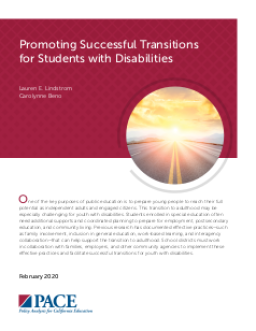A Summary of the PACE Policy Research Panel
Published
Summary
Over 725,000 California K-12 students received special education services in 2018-19, but the system is not always equipped to serve them. Early screening, identification, and intervention, as well as better transitions, educator support, and mental/physical health services, need improvement. A Multi-Tiered System of Supports (MTSS) framework in schools could address SWDs' needs, but it requires additional resources and policy support to improve educator capacity and collaboration between agencies while systematizing data on SWDs.
Published
Summary
Students with disabilities should be included in programs that prepare them for life after high school. This can be achieved through a K-14 work-based learning model, which involves strengthening expectations, leveraging opportunities, and integrating supports. Early implementation of these actions is encouraged, along with specific policy recommendations for California.
Published
Summary
Preparing youth with disabilities for adulthood can be challenging, requiring additional supports and coordinated planning. Effective practices, such as family involvement, inclusion in general education, and interagency collaboration, can facilitate successful transitions to employment, postsecondary education, and community living. School districts must work with families, employers, and community agencies to implement these practices.
A Research Summary and Implications for Practice
Published
Summary
Given the importance of a college degree for both individual and societal economic prosperity, policymakers and educators are focused on strengthening the path to college beyond college entry. In this report, we synthesize the existing literature on four factors key to educational attainment—aspirations and beliefs, academic preparation, knowledge and information, and fortitude and resilience—and the implications of each.
Published
Summary
Public education in California shows progress, yet challenges remain in providing equal opportunities for all students. Poverty rates persist, and schools are highly segregated by race, ethnicity, family income, and language. While student outcomes are improving, significant achievement gaps exist, and California students perform worse than their peers in other states. Career technical education programs provide opportunities for diverse students, but there are gaps in tracking students' educational trajectories.
Published
Summary
This brief examines the use of student test scores in teacher evaluations in CA. It argues that current evaluation methods are not effective, and that alternative methods of measuring teacher effectiveness, such as peer evaluations and student surveys, should be explored. The brief also discusses the potential consequences of over-reliance on test scores, such as teaching to the test and neglecting non-tested subjects. It concludes that teacher evaluations should be designed to provide useful feedback for professional development, rather than being used solely for accountability purposes.





